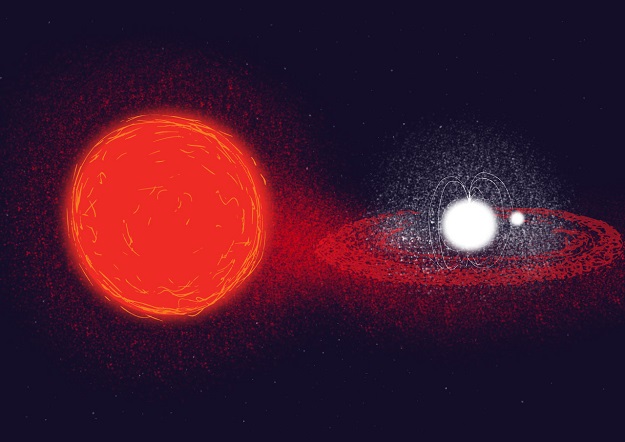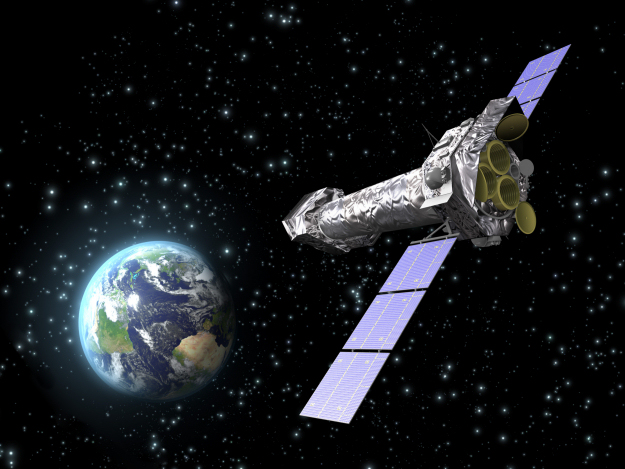Mysteriously in-sync pulsar challenges existing theories
13 September 2019
For the first time, astronomers have detected synchronised pulses of optical and X-ray radiation from a mysterious pulsar some 4500 light years away. The observations indicate that a new physical mechanism might be needed to explain the behaviour of fast-spinning sources like this one, known as transitional millisecond pulsars. |
| Artist's impression of the transitional millisecond pulsar PSR J1023+0038, accreting matter from its stellar companion. Credit: ESA |
The discovery was made as part of a two-day observation campaign spearheaded in 2017 by ESA's XMM-Newton X-ray observatory and other telescopes in space and on ground, including the optical Galileo National Telescope, which is operated by INAF, Italy's National Institute for Astrophysics, and located in the Canary Islands. The combination of both facilities allowed astronomers to measure with very high temporal resolution the two types of radiation coming from the ultrafast rotating pulsar.
Pulsars are highly magnetised, fast spinning neutron stars – the relics of massive stars. They are very dense objects, comprising up to two times the mass of the Sun within a radius of only ten km.
The pulsar analysed in this study, known as PSR J1023+0038, spins around its axis within a few thousandths of a second, completing hundreds of rotations every second. Such pulsars are classed as millisecond pulsars. Among these objects, some are also sucking in matter from a companion star – as is the case of this pulsar – and the accretion could explain their fast-spinning behaviour.
But astronomers suspected something might be different with PSR J1023+0038. Earlier studies had shown that this pulsar belongs to the rare category of so-called 'transitional millisecond pulsars' that periodically switch between two different modes of emissions – in X-rays and radio waves.
According to the leading model explaining this unusual behaviour, the accretion of matter from the companion star gives rise to the pulsed X-ray emissions, while the radio signal is thought to result from the rotation of the pulsar's magnetic field. In order to transition between the two types of emissions, the pulsar would have to alternate between the two behaviours, which cannot occur at the same time.
Further observations of PSR J1023+0038, however, revealed that an entirely different explanation might be needed to understand this class of sources.
"PSR J1023+0038 is the very first milisecond pulsar discovered with pulsations also in the optical band," said Alessandro Papitto from INAF in Rome, Italy, lead author of the new study.
"It is a bit like a lighthouse that alongside the optical flashes also emits a beam of X-rays," he added.
 |
| Artist's impression of the XMM-Newton observatory. Credit: ESA |
When the researchers first discovered the optical signal alongside the X-ray pulses, they thought each emission would be caused by a different behaviour, just like in other known transitional pulsars. In fact, theoretical models show the rotating magnetic field could create an optical signal, similarly to what happens with the radio signal.
The latest data, however, show that the optical pulses in PSR J1023+0038 appear and disappear at exactly the same time as the X-ray ones. According to Papitto, this is difficult to reconcile with the existing scenario: if emitted in unison, these signals must have the same origin.
When we set up the observations, we thought that the pulsar would oscillate between optical and X-ray pulsations," said Papitto. "That would mean that the system is changing its state very fast between the two emission modes. But we actually saw that the two types of pulsations occur simultaneously for tens of minutes, then shut down together and come back together again."
 |
| The Galileo National Telescope. Credit: INAF / R. Cerisola |
The team tried to explain the synchronised pulses with conventional models, but to no avail. The optical signal is too bright to be a by-product of accretion, as in the case of the X-ray pulses. Models based on the rotation of the pulsar's magnetic field, such as the ones that explain the radio pulsations, also fell short.
Papitto and collaborators therefore proposed a new scenario that could explain the data.
"We are observing something completely different from other kinds of pulsars," said Papitto. "We thought that perhaps the pulsar emits a strong electromagnetic wind, which then interacts with the accretion disc around the system."
As the pulsar wind hits matter in the accretion disc, it creates a massive shock, which accelerates electrons in the wind to extremely high speeds. The electrons then interact with the wind's magnetic field, producing powerful beams of synchrotron radiation that can be observed in the optical and X-ray bands at the same time.
"We think that this shock region between the wind of the pulsar and the accretion disc acts like a screen where energy is deposited," explained Papitto. "This energy is then rapidly re-radiated all at once, leading to the observed pulse of optical and X-ray radiation every rotation."
Unlike in other pulsars, the accretion disc does not reach all the way to the pulsar's surface but is truncated by the wind roughly a hundred km away, therefore not contributing to the bulk of the X-ray emission and the speed of the pulsar's rotation as other models assume.
The new model provides a possible explanation for the simultaneous pulses, but more data will be needed to validate the theory. For example, the model predicts a tiny time lag, of only a few hundred microseconds, between the optical and X-ray signal, which is still to be confirmed in the data.
"We want to check if there is any the time lag between the pulsations to test our model, as it takes a little bit longer to emit visible light than X-rays," said Papitto. "But uncertainties are still large so we need to measure the pulses again and with greater accuracy."
The new model could explain other puzzling behaviours of transitional millisecond pulsars that are not fully understood – such as the simultaneous presence of the accretion behaviour and rotation-powered pulsar characteristics, which should be mutually exclusive.
"Making such observations requires very high time resolution, detecting individual photons and tagging their time of arrival with the accuracy of microseconds," said ESA XMM project scientist Norbert Schartel.
"It is really fortunate that XMM-Newton allows for such detailed temporal variability studies, even though it was not designed with such a purpose in mind. This testifies to the great versatility of the observatory, which has enabled a wide range of discoveries over the past two decades."
The astronomers are looking forward to future improvements in the technologies enabling to identify the arrival time of individual photons at optical wavelengths, which would further enhance understanding of pulsars like PSR J1023+0038.
Notes for editors
"Pulsating in unison at optical and X-ray energies: Simultaneous high-time resolution observations of the transitional millisecond pulsar PSR J1023+0038" by A. Papitto et al. is published in the Astrophysical Journal.
The study combines: X-ray observations from ESA's XMM-Newton and NASA's NuSTAR and NICER X-ray observatories; ultraviolet observations from NASA's Swift; optical observations from INAF's optical Galileo National Telescope (TNG), equipped with the Silicon Fast optical Astronomical Photometer, SiFAP, developed at Sapienza University of Rome, Italy, and the Nordic Optical Telescope (NOT) – both located at Roque de los Muchachos Observatory, in La Palma, Canary Islands, Spain – as well as from the Telescopi Joan Oró (TJO), located at the Montsec Observatory in the Catalan pre-Pyrenees, Spain; and infrared observations from the Gran Telescopio Canarias (GTC), also on the island of La Palma.
For more information, please contact:
Alessandro Papitto
National Institute for Astrophysics (INAF)
Osservatorio Astronomico di Roma, Italy
Email: alessandro.papitto inaf.it
inaf.it
Norbert Schartel
XMM-Newton project scientist
European Space Agency
Email: norbert.schartel esa.int
esa.int



